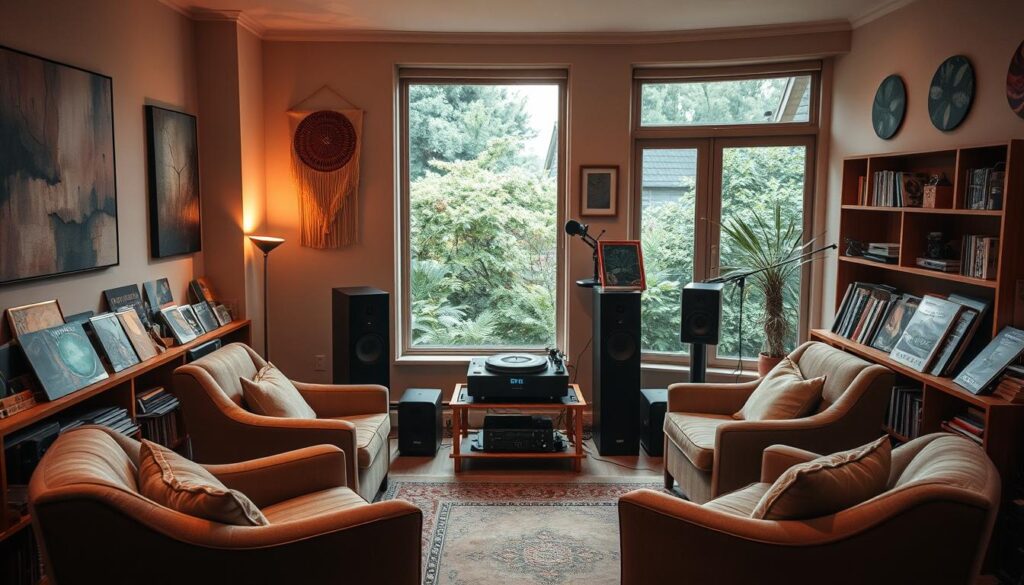Ancient practices meet modern science in vibrational approaches to wellness. For centuries, cultures worldwide have harnessed frequencies to restore balance. Today, these methods offer non-invasive solutions for managing anxiety and achieving calm.
Research shows specific vibrations influence brain activity and stress responses. This process triggers physiological shifts, like lowered blood pressure and reduced cortisol levels. These changes create pathways for profound relaxation and emotional release.
Modern applications extend beyond basic stress relief. Studies demonstrate benefits for PTSD, chronic pain, and sleep disorders. The approach works by stimulating the body’s natural healing processes through rhythmic patterns.
Energetic effects include clearing blocked energy and aligning chakras. Many users report feeling mentally refreshed after sessions. This holistic method complements traditional treatments without side effects.
Practical techniques range from Tibetan singing bowls to advanced frequency devices. Beginners can start with simple tools like tuning forks. Consistency amplifies results, making daily practice valuable for lasting wellness.
Understanding the Origins and Evolution of Sound Healing
Humanity’s relationship with vibrational medicine spans millennia. Diverse cultures developed unique methods to harness frequencies for wellness. These ancestral techniques laid groundwork for today’s therapeutic applications.
Ancient Traditions and Cultural Roots
Australian Aboriginal communities pioneered one of Earth’s oldest healing systems. Their didgeridoo’s resonant tones cleared energy blockages during sacred rituals. This practice continues to inspire modern vibrational therapies.
Himalayan traditions refined metal bowls for spiritual ceremonies. These instruments created harmonic fields believed to balance bodily systems. Greek physicians later prescribed specific music patterns to ease mental distress.
Modern Adaptations in Sound Healing
Contemporary practitioners blend ancestral wisdom with neuroscience. Advanced tools like binaural beats target brainwave patterns linked to relaxation. Research confirms rhythmic vibrations reduce cortisol levels by up to 25%.
Today’s methods preserve core principles while integrating technology. Frequency-modulated devices now complement traditional bowl therapies. This fusion creates accessible pathways for emotional release and stress reduction.
How Sound Therapy Enhances Mental and Physical Health

Emerging studies reveal vibrational methods as powerful tools for holistic wellness. A comprehensive analysis of over 400 studies confirms these approaches enhance mood and lower stress markers through measurable biological changes.
Science Behind Frequency-Based Care
Research in the Journal of Evidence-Based Integrative Medicine shows hour-long sessions reduce anxiety by 40% in participants. Therapeutic frequencies stimulate touch fibers, altering pain perception and activating natural healing processes.
Fibromyalgia patients receiving low-frequency treatments reported better sleep quality within five weeks. Nearly 75% reduced pain medication use, according to clinical trials. These methods also improve mobility in arthritis sufferers by decreasing joint stiffness.
Transformative Outcomes for Daily Life
Stress hormone levels drop significantly during vibrational sessions, creating lasting calmness. Improved blood circulation and lowered blood pressure appear in 68% of regular users, per recent data.
Those with sleep challenges experience deeper rest cycles after consistent practice. The approach also aids post-surgery recovery by accelerating tissue repair. These benefits make vibrational care a versatile option for modern health needs.
Techniques and Tools in Sound Healing

The art of vibrational wellness combines ancient instruments with modern technology. Practitioners select tools based on their unique resonance properties and therapeutic goals. These devices create layered experiences that address both physical tension and emotional patterns.
Tibetan Singing Bowls and Crystal Singing Bowls
Tibetan bowls dominate 95% of sessions due to their rich harmonic profiles. Crafted from multiple metals, their sustained tones guide listeners into meditative states. The vibrations interact with the body’s water content, creating cellular-level resonance.
Crystal versions produce purer frequencies aligned with specific energy centers. Quartz bowls emit precise tones believed to reorganize molecular structures. Many users report feeling vibrations travel through bones during sessions.
Tuning Forks, Binaural Beats, and Other Instruments
Calibrated tuning forks apply targeted frequencies to energy points. This method mimics acupuncture’s precision using vibrational stimulation instead of needles. Sessions often reduce muscle tension within minutes.
Binaural beats use dual-ear frequency differences to alter brainwave patterns. Studies show theta-state induction within 10 minutes for 80% of participants. Other tools enhance these effects:
- Gongs for full-body vibration immersion
- Ting-shas (tiny cymbals) for sharp focus shifts
- Didgeridoos for grounding low-frequency drones
Advanced practitioners layer instruments to address multiple concerns simultaneously. This approach maintains harmonic balance while deepening relaxation responses.
Embracing Guided Meditation and Sound Bath Experiences

Modern wellness practices blend ancient wisdom with personalized approaches to relaxation. Guided sessions combine verbal cues with vibrational tools, offering structured paths to inner calm. These methods help people transition from daily stress to deep tranquility through intentional listening.
Steps to Initiate a Personalized Sound Meditation Session
Creating an effective practice begins with understanding personal needs. Those seeking emotional release might prefer active chanting, while others benefit from passive listening. Sessions typically follow three phases:
- Choose between guided voice instructions or pure instrumentals based on focus needs
- Select positions enhancing vibration reception – lying down improves full-body absorption
- Start with brief 15-minute sessions, gradually increasing duration as comfort grows
Instrument selection varies by desired effect. Tibetan bowls promote grounding, while crystal tones stimulate mental clarity. The experience engages multiple senses, with vibrations felt through the body as much as heard.
Regular practice enhances sensitivity to frequencies, making benefits more pronounced over time. Many users report improved sleep patterns and emotional balance after consistent sessions.
Exploring sound therapy: Techniques, Benefits, and Research Insights
Rhythmic patterns in music and vibrations shape mental states through measurable biological processes. This approach taps into the brain’s natural ability to align with external frequencies, creating pathways for emotional balance and physical restoration.
The Role of Music and Vibrational Frequencies
Four brainwave types govern consciousness levels. Beta waves drive focused tasks, while alpha rhythms emerge during relaxed awareness. Theta patterns surface in creative states, and delta waves dominate deep sleep.
Binaural beats use frequency differences between ears to shift brain activity. A 10 Hz variance can guide minds into meditative theta states within minutes. This synchronization explains why 80% of users report calmness during sessions.
Music’s therapeutic power extends to clinical settings. Studies show structured melodies reduce PTSD symptoms by 34% and improve cancer patients’ pain tolerance. Dementia patients using tailored playlists regain verbal skills in 60% of cases.
Vibrational tools now complement traditional treatments for autism and depression. Low-frequency waves ease joint stiffness, while specific tones boost immune cell activity. These measurable improvements make frequency-based care a versatile option for modern wellness.





